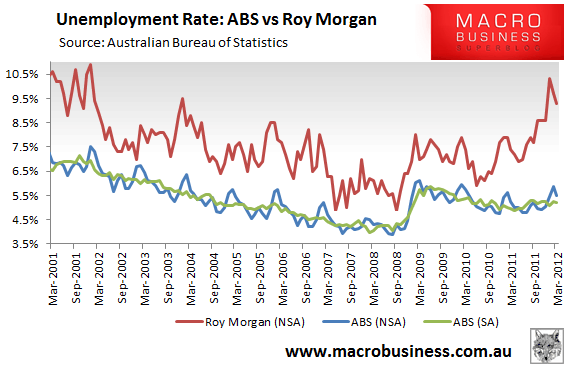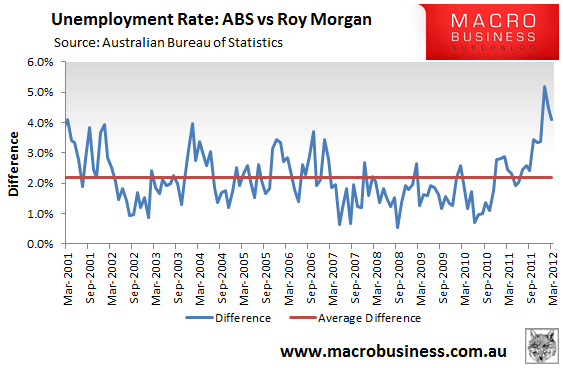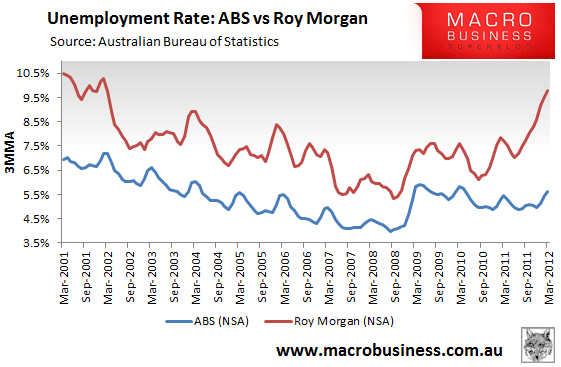
By Leith van Onselen
Earlier this month, Australia’s unofficial provider of labour force data, Roy Morgan Research, released its employment figures for March, whereby it estimated that 9.3% of Australians were unemployed, down -0.4% from February 2012.
As explained previously, Roy Morgan Research measures employment differently from the Australian Bureau of Statistics (ABS), which is Australia’s official provider of labour force data:
According to the ABS definition, a person who has worked for one hour or more for payment or someone who has worked without pay in a family business, is considered employed regardless of whether they consider themselves employed or not.
The ABS definition also details that if a respondent is not actively looking for work (ie: applying for work, answering job advertisements, being registered with Centre-link or tendering for work), they are not considered to be unemployed.
The Roy Morgan survey, in contrast, defines any respondent who is not employed full or part-time and who is looking for paid employment as being unemployed…
Since Roy Morgan uses a broader definition of unemployment than the ABS, it necessarily reports a higher unemployment figure. In addition, Roy Morgan’s measure tends to be far more volatile, owing to the fact that it draws on a smaller sample than the ABS and is not seasonally adjusted.
Following the release of the ABS labour force data for January, which registered a surprise fall in Australia’s unemployment rate from 5.2% to 5.1%, the head of Roy Morgan Research, Gary Morgan, claimed that the ABS unemployment estimate “defy belief and common sense” and suggested that “the ABS figures are diverging from reality” in light of the “constant stream of companies announcing retrenchments in the early stages of 2012″.
Gary Morgan also argued that the ABS measure is a lagging indicator as it “only classifies an unemployed person as part of the labour force if, when surveyed, they have been actively looking for work in the four weeks up to the end of the reference week“, whereas the Roy Morgan estimate “provides a more accurate picture of what is happening on the ground” since its “estimates are taken at that point in time“.
In light of the release of the ABS March labour force data last week, which produced no change in the official unemployment rate (5.2% seasonally adjusted) despite the creation of 44,000 jobs, I considered it worthwhile to once again compare and contrast the ABS unemployment estimate with Roy Morgan’s March release.
The below chart plots the ABS seasonally adjusted (SA) and non-seasonally adjusted (NSA) unemployment rate series against Roy Morgan’s NSA series:

Focusing on the non-seasonally adjusted (NSA) series only, you can see that there was some convergence in the Roy Morgan and ABS measures in March, although they remain far apart, historically so. In January, the Roy Morgan estimate was 5.2% higher than the official ABS measure – the highest divergence in the series’ 11-year history. However, in March, the difference fell to 4.1%, which is still way above the average divergence of 2.2% over the life of the series (see below chart).

When both series are charted on a 3-month moving average (3MMA) basis (in order to reduce volatility), you can see that they tend to be highly correlated – it’s just that something weird has happened recently that has pushed the two series wide apart:

I noted previously that it remains to be seen whether Roy Morgan’s estimate is right or wrong with respect to the direction of the labour market. That is, either Roy Morgan’s unemployment rate will retrace sharply in coming months (beyond usual seasonal movements), the ABS figure will deteriorate toward Roy Morgan’s, or some combination of the two.
Given the strong ABS employment figures for March, Roy Morgan’s survey at this stage looks to be the outlier. However, with the ongoing weakness in the retail sector, the number of dwelling approvals contracting, and the rate of credit issuance remaining highly subdued, it is still possible to see the two indexes as intact. The different methodology of the Roy Morgan index is more sensitive to underemployment and may be more strongly registering the churn we are seeing in the labour market between sectors. I still expect to see the two converge at a higher official rate in the coming months.

